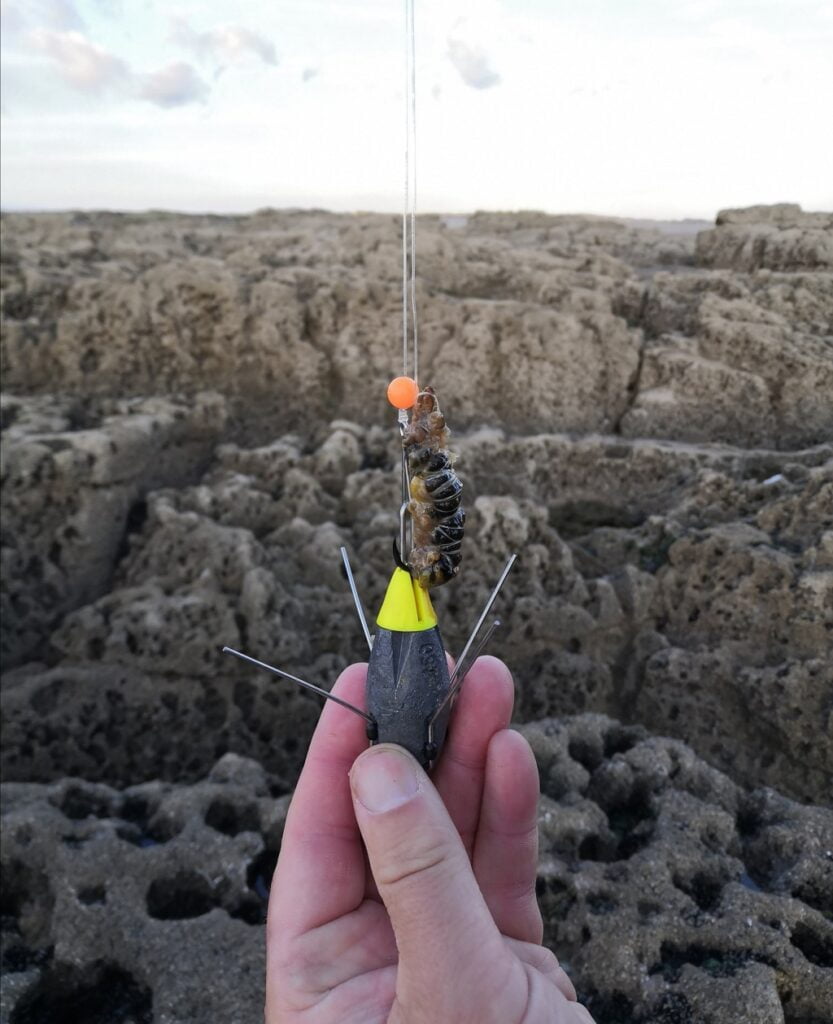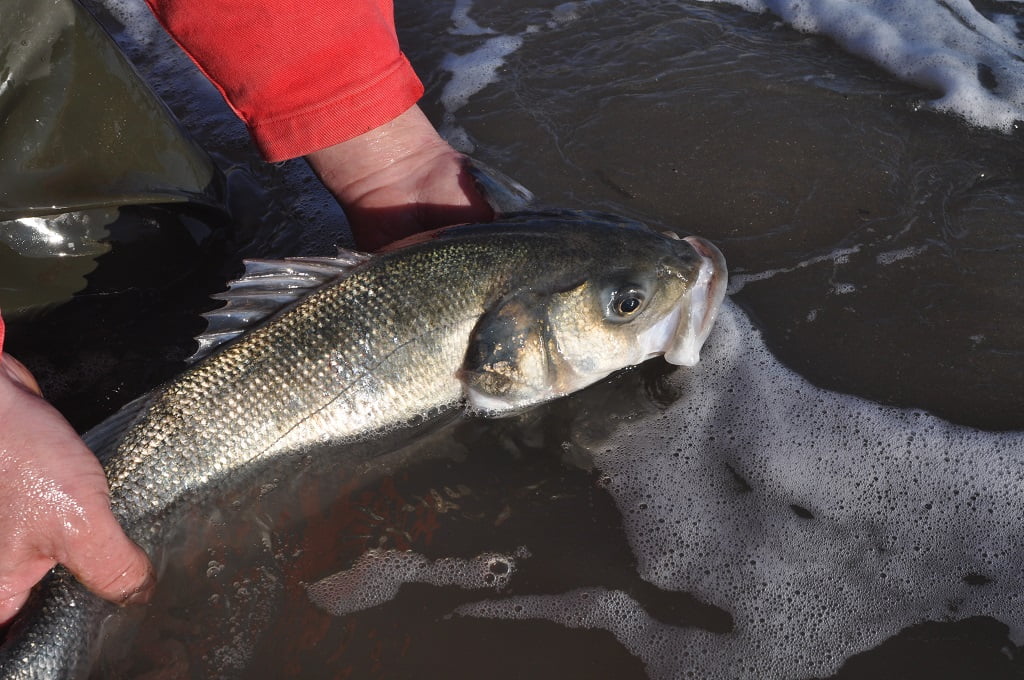Got crabs? Go bass fishing in Wales!!
Dave Lewis explores and explains the virtues of early season bass fishing and why having crabs will certainly hold you in good stead for sport before the sea starts to warm up.
Were anyone ever to sit down and create a blueprint for the ideal rough ground bass venue, then much of the Welsh coastline would be as good a starting point as I have seen.
Vast stretches of our coastline consist of rock that over the millennia has been geologically sculptured by countless tides and storms to create prominent ledges and reefs that are intersected by deep, kelp filled gullies. Along with numerous tidal islands, marks that invariably offer great fishing, you’ll find lots of outcrops along with a plethora of deep rock pools = bass country!

Throughout the rocky inter-tidal zone food for foraging bass is both plentiful and varied, with an abundance of crabs and prawns, along with many small fish upon which to snack. Such areas offer the cream of shore bass angling; ledgering a juicy lump of prime peeler crab in the gullies and along the reef edges, invariably at surprisingly close range.
Rocky areas are not only ideal for bass but conveniently over low water many are also perfect for collecting fresh peeler crab. Then, following collection, you fish this most natural and deadliest of bass baits in the same gullies and deeper pools when once again the flooding tide reclaims them.

At many marks mid-range tides tend to be the most productive for bass, though low water over the biggest tides will usually offer the very best opportunities for ‘crabbing’, as then the tide uncovers ground rarely exposed other than during the highest tides of the month, the ‘Spring’ tides that coincide with both a full and a new moon. Depending on the weather, crabs start to peeler as the sea temperature warms up, the first crabs usually start to peel in March, with April to June being the peak crab peeling season – the autumn too if the weather remains mild, and fresh peeler crab will catch bass whenever you can obtain it. Good tackle shops stock live peeler crab throughout most of the year.
The common green shore crab are a great bait when available in peeling condition but when they can be obtained, either the velvet swimming or edible crabs are even better. Please be aware that in Wales the minimum size for edible crabs when measured across the broadest part of the back is 140mm.
Also, when hunting for peeler crabs please be sure to return all rocks you lift to exactly the same position, else you will cause unnecessary damage to the fragile local habitat.

Identifying peeler crabs
In order to grow, crabs first develop a complete new skin beneath the existing shell. When they are ready to shuck the old shell they absorb water, which has the effect of splitting the crabs top shell, or carapace.
These splits to either side of the carapace are one of the easiest ways to identify when the crab is in absolute peak condition for use as bait. Carefully twisting the very end segment of one leg is another. If the crab is a peeler the old shell will come away easily, revealing a new, perfectly formed leg beneath. Once the crab has peeled it will be soft and jelly like, still an excellent bait, until over the course of a few days the new shell hardens.
Mount the crab onto the hook using fine elastic, either whole or in sections depending on the size of crab. A bait about the size of a dairylea triangle is about right!

Bass fishing over rough ground
Obviously when fishing rough ground tackle losses are to be expected, so it is important to ensure your leads are attached via a rotten bottom; that is a short length of weak line. If, or I should say when a lead snags, a steady pull will break the weak line thus minimising tackle losses.
Distance casting when fishing for bass over rough ground is rarely necessary, indeed it can be counterproductive. A suitable bait lobbed perhaps just 20-30 yards out into a gully is perfect, and this is the reason why not so many bass are caught at certain venues- the majority of anglers are fishing too far out to catch them.
If specifically looking for bass at short range I’ll usually use a single hook paternoster, tied with something like a bronzed Viking 4/0; a running paternoster rig incorporating a rotten bottom is the perfect rig. If fishing at range then the pulley pennel is a popular choice with many bass anglers.
Best times for a bass bite
Bass can be caught both during the day and at night, though from my experience fishing at night will likely produce most bass. Ideal conditions are when a gentle swell is pushing in out of the south-west, as this encourages bass to move in tight to the surf line looking for items of food that get washed out of the rocks.

Standing on the edge of a kelp filled rock gully holding your rod as the surge of swell pulls gently on your line, waiting for the heart stopping thump that confirms a fish has taken your bait is one of sea anglings great experiences, why not try it yourself this spring?
SAFETY: Most shore bass fishing is low water affair, with anglers concentrating on fishing two to three hours either side of bottom tide. Consequently there will always be a risk of having your retreat cut off by a rising tide, especially if fishing tidal islands.
Always research new venues thoroughly before fishing, local tackle shops are a valuable source of information. Make certain someone knows exactly where you are fishing and at what time you expect to return.
Words: Dave Lewis
Images: Dave Lewis and Alan Parfitt
This feature was originally published in the ‘Wild Fishing Wales E-Zine’. Reproduced with permission of NRW.
New to the sport? If you are looking to try sea fishing in Wales for the first time, then check out our beginners guide to shore fishing.
YouTube Channel
Did you know Fishing in Wales has a YouTube channel?? With over 40 game, coarse and sea fishing videos ready to watch, we will be uploading many more videos showcasing the best of Welsh angling over the coming months.
So why not SUBSCRIBE HERE to keep up to date with video content as it lands…

No Cod? Try These! Winter Sea Species to target in Wales
In this latest blog from sea angling writer Dave Lewis we take a look at the winter sea fishing species…
Read More
Five fishing resolutions for the New Year
Wales has so much to offer for 2026, with angling opportunities in abundance for seasoned fishers or newcomers to the…
Read More
EPIC Welsh Fishing Lakes & Reservoirs from the Sky VIDEO
This cinematic drone montage showcases some of the most epic fishing lakes and reservoirs across Wales, from vast open waters…
Read More



